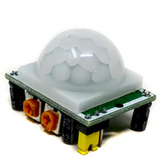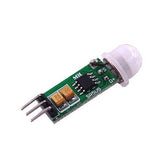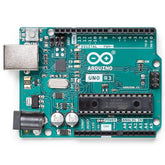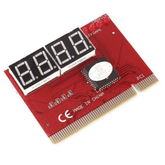Motion Sensor: Definition, Working, Uses, Project Ideas
Summary
You might have walked into a room and the lights automatically lit up. Or approached a door and it opened on its own.
These everyday conveniences are powered by motion sensors: compact electronic devices that detect movement and trigger automated responses.
From home security systems to energy-efficient lighting, motion sensors have revolutionized modern living.
Understanding how these devices work, their various types, and practical applications opens up endless possibilities for students, engineers, and DIY enthusiasts alike.
Let's explore the fascinating world of motion detection technology.

What Is a Motion Sensor?
A motion sensor is an electronic device specifically designed to detect physical movement within a defined area and convert that movement into an electrical signal.
Think of it as an electronic guard that never blinks, constantly monitoring its surroundings for any change or movement.The motion sensor device operates by sensing variations in its environment, whether through changes in heat signatures, reflected sound waves, or electromagnetic fields.
The beauty of a motion detection sensor lies in its ability to trigger automated responses without human intervention.

When movement is detected, the sensor generates an output signal that can activate various actions: turning on lights, sounding alarms, opening doors, or recording video.Modern motion sensors range from simple single-purpose detectors to sophisticated multi-sensor systems that can distinguish between different types of movement.
These devices have become indispensable in numerous applications because they provide a seamless bridge between the physical world and electronic systems.A motion sensor switch, for instance, can automatically control lighting based on occupancy, helping reduce energy consumption in homes and offices.
The technology has evolved significantly since its inception, becoming smaller, more accurate, and more affordable, which has enabled its widespread adoption in consumer electronics, security systems, and Internet of Things (IoT) devices.
How Do Motion Sensors Work
Understanding how motion sensor works requires exploring the fundamental principles that enable these devices to detect movement. The working principle of motion sensor technology can be categorized into two main approaches: active detection and passive detection.

Passive Detection:
Passive sensors, particularly Passive Infrared (PIR) sensors, are the most common type of motion detector in consumer applications. These sensors work by detecting changes in infrared radiation emitted by warm objects, primarily humans and animals.
Every living being emits infrared radiation as heat, and PIR sensors are specifically designed to detect variations in this thermal signature.
- The sensor contains pyroelectric materials that generate an electrical charge when exposed to infrared radiation
- Two sensing elements are positioned side by side, creating a differential detection system
- When a warm body moves across the sensor's field of view, it first activates one sensing element, then the other
- This differential change generates a positive and negative electrical pulse, which the sensor interprets as motion
- A Fresnel lens covering the sensor divides the detection area into multiple zones, increasing sensitivity
Active Detection:
Active sensors take a different approach by emitting energy and measuring the reflections that return. These systems include both a transmitter and a receiver, working together to detect disturbances in the emitted signal.
- Ultrasonic sensors emit high-frequency sound waves beyond human hearing range (typically 25-40 kHz)
- The sound waves bounce off objects and return to the sensor
- By measuring the time it takes for echoes to return, the sensor calculates distance and detects movement
- Microwave sensors emit electromagnetic waves and analyze the frequency shift of reflected signals (Doppler effect)
- When an object moves toward or away from the sensor, the frequency of reflected waves changes, indicating motion
The motion detector sensor processes these signals through integrated circuits that amplify and filter the detection signal, eliminating false triggers from minor environmental changes.
Most modern sensors incorporate adjustable sensitivity controls and time delays to optimize performance for specific applications.
What do motion sensors sense?
Motion sensors detect various physical phenomena depending on their type and design. Understanding what these sensors can and cannot detect helps in selecting the right sensor for specific applications.
Heat Signatures:

PIR sensors primarily detect infrared radiation emitted by warm bodies. They are particularly effective at sensing humans and animals because of their body heat, typically detecting movement within a temperature range of 20-40°C.
These sensors excel at identifying the heat contrast between a moving warm object and the cooler background environment.
Movement and Position Changes:
All motion sensors fundamentally detect changes in position rather than absolute position. They respond to dynamic changes in their monitored area, whether it's a person walking, a door opening, or an object being moved.
The speed of movement can also affect detection, with most sensors having optimal sensitivity ranges for human walking speeds.
Distance and Proximity:
Ultrasonic and microwave sensors excel at measuring distance changes. They can determine not only that something has moved but also how far away it is and in what direction it's moving. This capability makes them valuable for applications requiring precise spatial awareness.
Environmental Disturbances:
Advanced motion sensors can detect subtle environmental changes such as air pressure variations, acoustic signatures, and electromagnetic field disturbances.
Some dual-technology sensors combine multiple detection methods to reduce false alarms and increase accuracy.
Types of Motion Sensors and Their Features
The world of types of motion sensor technology offers diverse options, each with unique characteristics suited for specific applications.
Passive Infrared (PIR) Sensors:
PIR sensors are the most popular choice for home automation and security applications. They detect infrared radiation changes caused by moving warm bodies.
- Highly energy-efficient, consuming minimal power (often microamps in standby mode)
- Effective detection range typically between 5-12 meters
- Cannot detect movement through walls or glass
- Ideal for indoor applications with controlled temperature environments
- Cost-effective and widely available for DIY projects
Ultrasonic Sensors:

These sensors emit high-frequency sound waves and measure the echoes that bounce back.
- Can detect any moving object regardless of temperature
- Effective through thin barriers and around corners due to sound wave propagation
- More expensive than PIR sensors but offer greater coverage
- May be affected by soft materials that absorb sound waves
- Excellent for parking assistance and automatic door systems
Microwave Sensors:
Microwave sensors emit electromagnetic waves and analyze frequency shifts in reflected signals.
- Highly sensitive and can detect through walls and non-metallic materials
- Larger coverage area compared to PIR sensors
- Higher power consumption than passive sensors
- May trigger false alarms from environmental factors
- Common in commercial and outdoor security applications
Dual-Technology Sensors:
These combine two detection methods (typically PIR and microwave) to minimize false alarms.
- Require both sensors to trigger before signaling motion
- Significantly reduced false alarm rates
- Higher cost but improved reliability
- Preferred for critical security applications
Tomographic Sensors:
Advanced sensors that create a mesh of radio waves to detect disturbances.
- Can detect through walls and obstacles
- Suitable for whole-building monitoring
- More complex installation and higher cost
Key Components Used in Motion Sensors
Understanding the internal components of motion sensors reveals how these devices achieve their detection capabilities.
Sensing Element:
The heart of any motion sensor is its primary sensing element. In PIR sensors, this consists of pyroelectric crystals that generate electrical charges when exposed to infrared radiation.
Ultrasonic sensors use piezoelectric transducers that convert electrical energy into sound waves and vice versa. Microwave sensors employ Gunn diodes or microwave oscillators to generate electromagnetic waves.
Fresnel Lens:
PIR sensors incorporate a Fresnel lens, a plastic optical component with multiple facets. This lens serves several critical functions: it focuses infrared radiation onto the sensing element, extends the detection range, and divides the field of view into multiple detection zones.
The segmented design creates alternating sensitive and blind areas, enhancing the sensor's ability to detect movement.
Signal Processing Circuit:
All motion sensors include electronic circuits that amplify weak detection signals and filter out noise. These circuits typically contain operational amplifiers, comparators, and logic gates that process the raw sensor output.
Advanced sensors incorporate microcontrollers that implement sophisticated algorithms for pattern recognition and false alarm reduction.
Output Interface:
The output stage converts processed detection signals into usable electrical signals. Common output formats include digital signals (high/low voltage levels), analog voltage proportional to detected intensity, and pulse-width modulated signals.
Some sensors provide relay outputs that can directly control high-power loads.
Power Supply Components:
Voltage regulators, filtering capacitors, and power management circuits ensure stable operation. PIR sensors typically operate on 5-12V DC, while more power-hungry microwave sensors may require higher voltages.
Adjustment Controls:
Many motion sensors include potentiometers or digital controls for adjusting sensitivity, detection range, and time delay. These allow users to customize sensor behavior for specific applications.
Where do people use motion sensors?
The motion sensor uses span across residential, commercial, and industrial applications, demonstrating the versatility of this technology. Understanding motion sensor applications helps identify optimal placement strategies for different scenarios.
Home Security Systems:
Motion sensors form the backbone of modern home security. Strategic placement includes entry points such as front and back doors, hallways connecting bedrooms, ground-floor windows in accessible areas, and stairways between floors.
The best placement for security sensors is typically in corners at ceiling level, providing the widest field of view with minimal blind spots.
Sensors should be positioned to detect crossing movement rather than direct approach, as this configuration maximizes detection reliability.
Automatic Lighting Control:
Energy-efficient lighting are one of the most popular real-life examples of motion sensors. Optimal locations include hallways and corridors, bathroom entrances, closets and storage rooms, garage and basement areas, and outdoor walkways.
For lighting applications, sensors should be mounted at heights of 2-2.5 meters with an unobstructed view of the area to be illuminated.
Avoid placing sensors near heat sources like HVAC vents or in direct sunlight, as these can cause false triggers.
Commercial Building Automation:
Commercial spaces leverage motion sensors for comprehensive building management. Office spaces use ceiling-mounted sensors to control lighting and HVAC based on occupancy, significantly reducing energy costs.
Conference rooms employ sensors that activate presentation equipment when people enter and power down systems during vacancy.
Restrooms benefit from motion-activated faucets, soap dispensers, and lighting, improving hygiene and resource conservation.
Retail and Customer Analytics:
Retail environments deploy motion sensors to track customer movement patterns and optimize store layouts. Entrance sensors count foot traffic, providing valuable business intelligence.
High-value merchandise areas use sensors to trigger discrete alerts when customers approach, preventing theft while maintaining a welcoming atmosphere.
Industrial Safety Systems:
Manufacturing facilities integrate motion sensors into safety protocols. Sensors around machinery detect human presence and can automatically stop equipment to prevent accidents. Loading dock doors use motion sensors to detect approaching forklifts, opening automatically, and improving workflow efficiency.
Healthcare Facilities:
Hospitals employ motion sensors for patient monitoring and staff efficiency. Sensors in patient rooms can detect falls or unusual inactivity, alerting nursing staff immediately. Hands-free door operation in sterile environments maintains hygiene standards.
Smart Home Integration:
Modern smart homes incorporate motion sensors throughout the living space. Living rooms use sensors to activate entertainment systems when family members enter.
Bedroom sensors can trigger nightlights when someone gets up at night, providing safe navigation without fully waking occupants.
Pet-immune sensors distinguish between animals and humans, preventing false alarms while maintaining security.
Motion Sensor Project Ideas for Students
Engaging in motion sensor projects provides hands-on learning experiences that bridge theoretical knowledge and practical application.
These DIY motion detection project ideas range from beginner to intermediate levels, offering students opportunities to develop electronics and programming skills.
1. Automatic Room Lighting System:
Build a smart lighting system that illuminates rooms automatically when someone enters and turns off after a preset delay when no motion is detected.
This project teaches fundamental concepts of sensor interfacing, relay control, and timing circuits.
Students learn about power management and energy efficiency while creating a practical solution for reducing electricity waste.
2. Intruder Alert System with SMS Notification:
Create a security system that detects unauthorized entry and sends SMS alerts to your phone.
This project integrates motion sensors with GSM modules and microcontrollers, teaching students about wireless communication and IoT concepts.
Adding features like photo capture using a camera module enhances the project's complexity and functionality.
3. Gesture-Controlled Device Interface:
Develop a hands-free control system using motion sensors to detect hand gestures for controlling electronic devices.
Students can program different gestures to execute various commands, such as adjusting volume, changing channels, or controlling home appliances.
This project introduces pattern recognition and signal processing concepts while creating an innovative user interface.
4. Automatic Visitor Counter:
Design a system that counts people entering and exiting a room or building using dual motion sensors positioned at entry and exit points.
The counter displays real-time occupancy on an LCD or LED display, useful for monitoring room capacity. This project teaches students about directional detection, counting logic, and data display techniques.
5. Wildlife Monitoring Camera Trap:
Construct an automated camera system that captures images or videos when motion is detected. This project combines motion sensors with camera modules and data logging capabilities, making it ideal for studying animal behavior or monitoring wildlife.
Students learn about low-power operation, outdoor weatherproofing, and long-term data collection strategies.
How to Interface a Motion Sensor with Arduino

The circuit diagram below illustrates a straightforward connection between a PIR motion sensor and an Arduino Uno microcontroller for creating motion detection applications.
Circuit Connections:
- The PIR motion sensor's VCC pin connects to the Arduino's +5V power supply, providing necessary operating voltage
- The sensor's GND pin links to the Arduino's ground rail, completing the electrical circuit reference
- The sensor's OUTPUT pin connects to a digital input pin on the Arduino (typically pin 2 or 3), transmitting the detection signal
- An LED with current-limiting resistor connects to a digital output pin on the Arduino (shown connected through the red wire)
- When the PIR sensor detects motion, its output goes HIGH, the Arduino reads this signal, and activates the LED as a visual indicator
- The USB connection provides power to the Arduino and enables program uploading and serial communication
- This basic configuration forms the foundation for more complex projects like alarm systems, automatic lighting, and visitor counters
Conclusion
Motion sensors have transformed how we interact with our environments, making spaces smarter, safer, and more energy efficient.
From passive infrared sensors detecting heat signatures to ultrasonic waves measuring distance, each technology offers unique advantages for specific applications.
Whether securing homes, automating lighting, or building student projects, motion sensors provide accessible entry points into electronics and IoT development.
As technology advances, these devices continue evolving with improved accuracy, reduced costs, and enhanced integration capabilities.
Mastering motion sensor fundamentals empowers innovators to create intelligent solutions that respond seamlessly to human presence and movement.




















